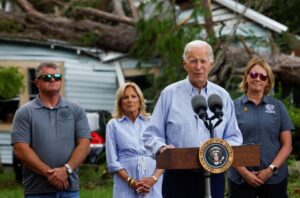WASHINGTON (Reuters) — The U.S. government’s flood coverage could soon find itself financially underwater. The National Flood Insurance Program, which covers nearly five million properties, needs to be reauthorized by Congress by the end of the month to avoid a housing crunch.
Yet a straightforward renewal would only extend the program’s debt-laden decline. A larger overhaul can help balance the scheme’s books while addressing some of the country’s home-affordability problems.
Should Congress fail to reauthorize the NFIP, purchases on some 1,330 homes would either be delayed or fail to close every day due to insurance uncertainties, according to the National Association of Realtors. That squeeze would add more friction to a housing market already pressured by historically low supply and the highest mortgage rates in two decades.
Simply extending the program’s lifespan doesn’t address more existential problems. First, it owes the Treasury $21 billion. Second, the program’s average annual premium rose from $736 to $935 in the 12 months through September 2022 amid a push to make it more solvent. But, perhaps because it is more expensive, it lost 61,000 policyholders over the past year. A FEMA report seen by the Associated Press estimated another 1 million fewer Americans will buy flood insurance by the end of the decade, further starving the program of much-needed funds.
The other end of the NFIP’s income statement is taking a hit, too. Major floods and storms have already cost the United States $38 billion this year, nearly tripling the historical yearly average, according to the National Oceanic and Atmospheric Association. NFIP payouts have ballooned as well. The program’s flood fund lost nearly $1.9 billion in fiscal 2022, up from a $236 million loss the year prior.
Congress has extended the NFIP’s deadline 25 times since 2017 without making major changes. Breaking that streak with some long-term investments can help fix its budget shortfall. Funding for tidal gates, improved drainage or natural defenses like mangrove forests could lower the odds of expensive damage and eventually ease households’ insurance costs. Added security from flood defenses can open new areas for much-needed home construction. Partnerships with countries like Singapore, which just opened a center for flood protection, could cut down on research expenses.
Including such measures in a reauthorization bill would initially lift government spending. Yet increasingly frequent weather disasters and a policyholder exodus will only grow the NFIP’s debt. Lawmakers shouldn’t take a rain check on updating the government’s flood protection.
CONTEXT NEWS
Congressional authorization for the U.S. National Flood Insurance Program is set to lapse on Sept. 30 if lawmakers don’t approve a new extension. The program would still be able to pay valid claims even if its authorization ends, but the Federal Emergency Management Agency, which runs the program, would no longer be able to sell new insurance policies or renew existing policies.
Hurricane Lee has intensified over the Atlantic Ocean to become a category 3 storm, with some further strengthening expected, the U.S. National Hurricane Center said on Sept. 11. It is not yet clear what level of impact Lee will have on the East Coast of the United States.
By BEN WINCK/Reuters
(The author is a Reuters Breakingviews columnist. The opinions expressed are his own.)
Follow @BenWinck on X
Editing by Lauren Silva Laughlin, Sharon Lam and Aditya Sriwatsav
Our Standards: The Thomson Reuters Trust Principles.

